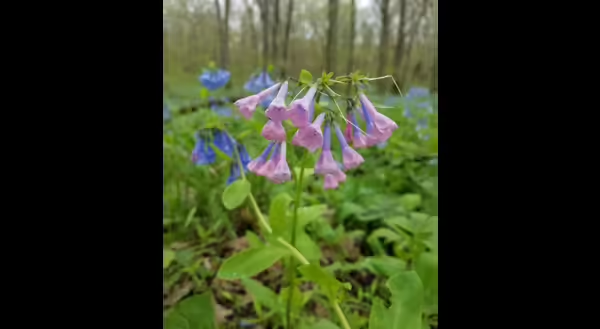
We all have our favorite spring wildflowers for one reason or another. Maybe they are part of a native plant community we visit often, such as a close-by natural area or favorite park trail? Perhaps our preference comes from the plants we are able to cultivate at home, in our own gardens? For me, it’s certainly hard to pick one favorite, I probably have a list a mile long of my “favorites”.
In recent years, the Virginia bluebell (Mertensia virginica) has moved up on my list for both its presence in my most loved local natural areas and its ability to thrive in cultivation. Although I’ve always loved this species out in nature, it wasn’t until we moved to our current home in 2017 that I started to pay closer attention to this plant.
Virginia bluebells are quite common across Illinois, occurring in nearly every county in the state. They thrive in the partial shade of woodlands with rich loamy soil, typically along floodplains but also stretching into more upland sites if both the soil and the habitat are of high enough quality. In the right habitat, they often form large patches creating a beautiful display this time of year.
As spring soils warm, this plant develops relatively quickly from its first emergence of beautiful, purplish early leaves to mature, light green foliage over the course of several weeks. It reaches peak flower display right around the frost free date each year and with its natural abundance around our property has become a plant symbolic of the start of the growing season for me.
Like many other spring wildflowers, bluebells do a lot to help support native fauna. Many pollinating insects, such as bees and some flies, visit bluebells for pollen or nectar this time of year. Hummingbirds (which just recently showed up at our feeders) have been noted to use bluebells in some areas. In the early season, patches of bluebells provide important cover for many native insects as they emerge. Even white-tailed deer have been observed browsing foliage on these plants before it disappears for the season in mid-summer.
As a landscape plant bluebells provide a great splash of blueish-purple to shade gardens in the early spring. I also really enjoy the bright green colored foliage that persists after flowering. These beautiful and delicate, oblong leaves eventually fade away by July, so put some thought into what can fill the void for the rest of the season.
Wild geraniums (Geranium maculatum) are a great companion plant to extend the flower display since they flower right after bluebells and keep the wave of purple-blue going for almost another month with their more delicate, lighter colored flowers. To fill in, bluebells look wonderful surround by native ferns, with a few of my favorites being lady fern (Athyrium filix-femina), cinnamon fern (Osmunda cinnamomea), Christmas fern (Polystichum acrostichoides) and maidenhair fern (Adiantum pedatum).
If you don’t have a native shade garden established yet, bluebells work great in an existing hosta garden. Individual plants can provide some color early in the early season before hostas fill in later.
Although I am huge advocate for adding native plants to our home landscapes, I do not recommend harvesting wild populations. In most all public natural areas, wild harvesting is prohibited to preserve native plant diversity. On private land, it is often very difficult to manage harvesting in a sustainable way without threatening their populations.
If you are interested in adding native wildflowers to your landscape, there are a number of local plant sales and native plant nurseries offering bluebells, and other species that do well in cultivation, from sustainably produced sources. Plants purchased from these outlets are not only supporting the preservation of native populations, but will most likely do better in cultivation since they were propagated by experienced professionals who design their production methods for the best results. For more information, the Illinois Native Plant Society does a great job of listing both native plant sales and native plant nurseries on their website, available at illinoisplants.org.